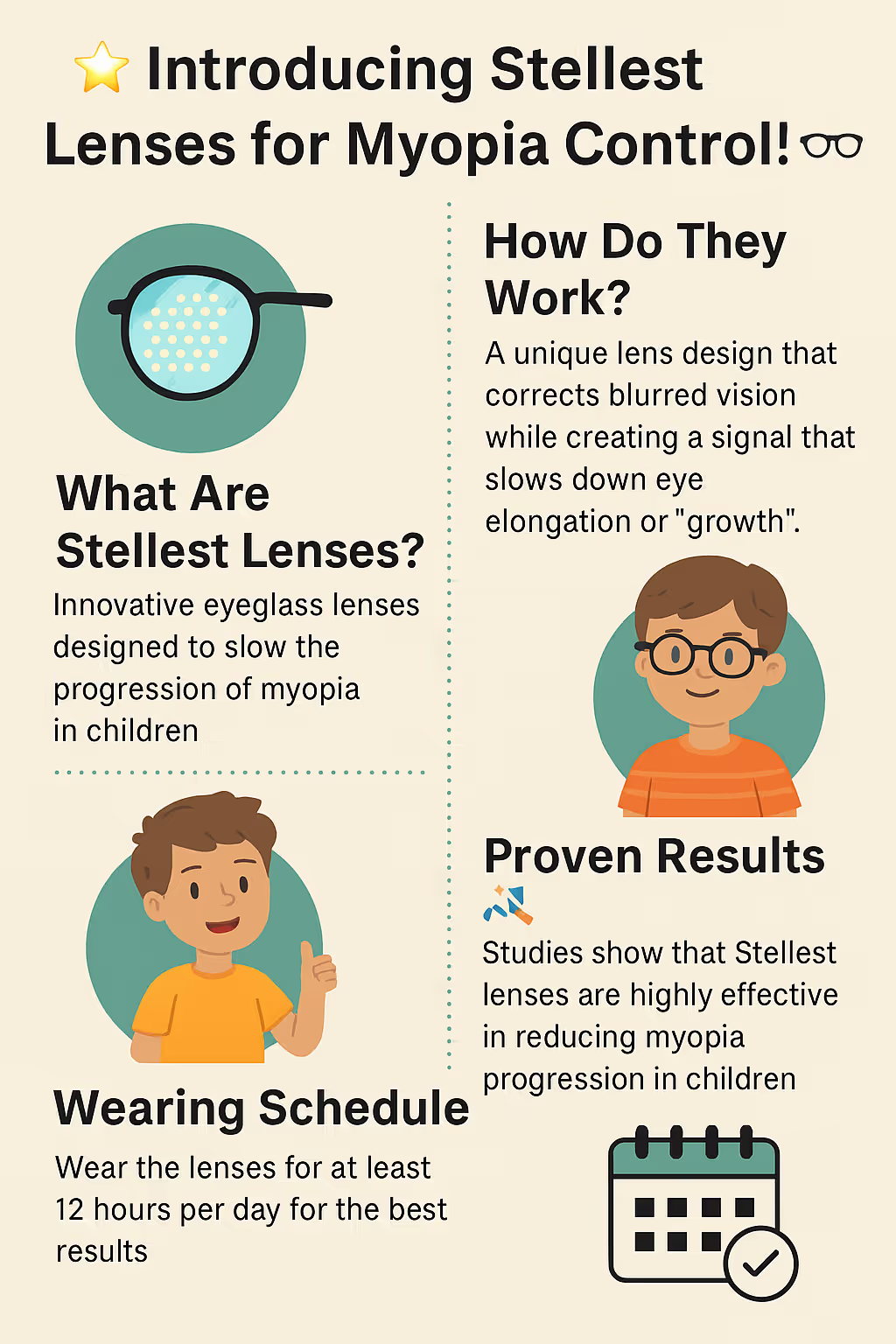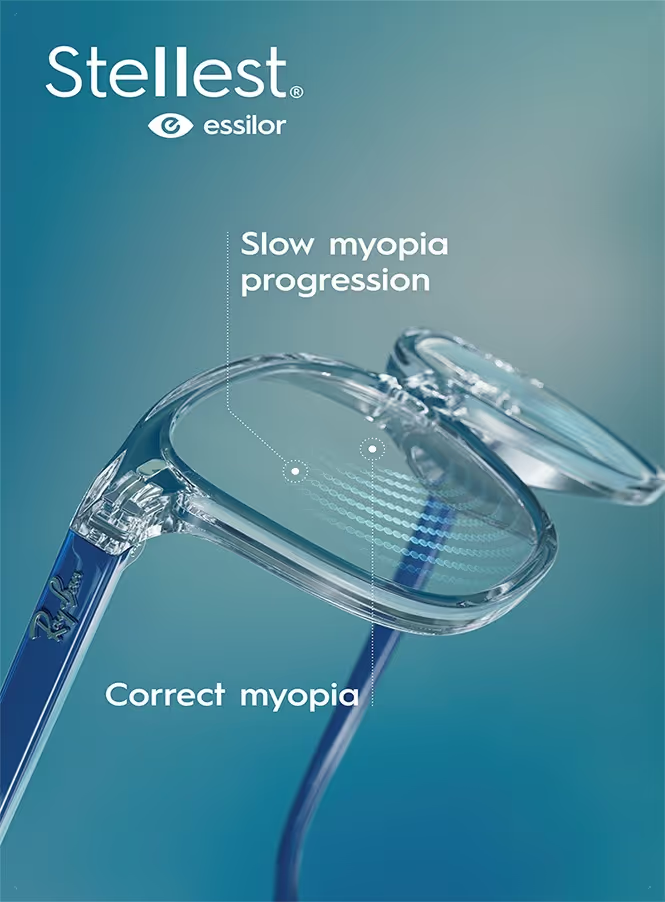Meet Stellest: The New FDA-Approved Lens That Slows Myopia in Children
If your child’s nearsightedness seems to be getting worse every year, you’re not alone. Childhood myopia (nearsightedness) has become one of the fastest-growing eye health concerns worldwide — and now, for the first time, there’s a glasses-based solution clinically proven to slow it down.
Introducing Essilor Stellest lenses — an innovative new spectacle lens that’s been FDA-authorized in 2025 to slow the progression of myopia in children. At Vision Care Center in Bellevue, we’re excited about what this means for families looking for safe, effective options beyond standard glasses or specialty contact lenses.
We strive to stay on the cutting edge of eyecare technology, and you can be assured that Dr. Jordan Jin at Vision Care Center prioritizes the most efficient and effective eye care possible.

1. What Is Stellest? 🧠
Stellest lenses look and feel like regular glasses, but they’re built with cutting-edge optical science.
Each lens has:
- A clear central zone for crisp distance vision
- A surrounding area made up of hundreds of invisible micro-lenslets, arranged in concentric rings
These lenslets gently defocus peripheral light, creating a “signal” that slows the eye’s natural tendency to grow longer (the main cause of myopia progression).
In other words: Stellest lenses don’t just correct your child’s vision — they actively help prevent it from getting worse.

2. Clinically Proven Results 📊
In clinical studies leading up to FDA authorization, children wearing Stellest lenses for two years showed:
- 71% slower progression of myopia compared to single-vision lenses
- 53% less axial elongation (eye growth)
- Best results when worn at least 12 hours per day
No serious adverse events were reported, and kids adapted quickly to wearing them.
3. Who Is Stellest For? 🎯
Stellest lenses are designed for children aged 6–12 years old who are already nearsighted or whose myopia is progressing.
They’re especially helpful for:
- Kids not ready for contact lenses (like Ortho-K or MiSight)
- Parents who want a non-invasive myopia control option
- Children who are struggling to keep their prescription from increasing every year
Stellest can even act as a bridge between traditional glasses and more advanced options like Ortho-K. However, Stellest has also been shown to be a very effective standalone treatment as well.
4. Why This Matters 🩺
Uncontrolled myopia isn’t just about thicker glasses — it increases the lifetime risk of retinal detachments, glaucoma, and other eye diseases later in life.
By slowing myopia progression early, we can help:
- Preserve your child’s vision
- Reduce future eye health risks
- Keep prescriptions more stable year to year
That’s why Vision Care Center has invested in full-scope myopia management services — from Ortho-K and MiSight to Stellest lenses, giving parents every option available.
5. How Stellest Compares to Other Myopia Control Options ⚖️
6. Our Myopia Control Expertise in Bellevue 👨⚕️👩⚕️👩⚕️
Between myself, Jackie, and Erica, our team has over 30 years of combined experience in eye care.
We take the time to:
- Explain every option clearly — no pressure, no rush
- Use 45-minute appointment slots to answer all your questions
- Customize each myopia control plan for your child’s needs and goals
That’s what makes Vision Care Center different from big box retailers — we don’t just prescribe lenses; we partner with parents to protect their children’s long-term vision.
FAQ: About Stellest Lenses
Q: Is Stellest available now?
A: Stellest received FDA authorization in 2025, and U.S. rollout is expected soon. We’ll notify families as soon as our office receives access.
Q: How long does my child need to wear Stellest lenses?
A: For maximum effect, they should be worn at least 12 hours per day, every day.
Q: Can Stellest cure myopia?
A: No — it doesn’t reverse nearsightedness. It slows the rate at which it worsens.
Q: Are Stellest lenses safe?
A: Yes. Clinical trials reported no serious side effects, only mild visual phenomena (like halos or slight blur) during initial adaptation.
Q: Can my child switch from Stellest to Ortho-K or MiSight later?
A: Absolutely. Stellest can be part of a progressive care plan — many families start with Stellest and later transition to contact lens-based myopia control.
Bottom Line
Stellest represents a major step forward in children’s vision care — the first FDA-authorized spectacle lens proven to slow myopia progression in the United States
At Vision Care Center in Bellevue, we’re proud to offer the latest technologies in myopia management, including Stellest, Ortho-K, and MiSight.
📅 Interested in learning whether Stellest is right for your child?
Schedule a myopia control consultation today — we’ll review all your options and help you make the best choice for your child’s long-term vision.
Dr. Jordan Jin
Vision Care Center
14700 NE 8th St, Ste 105
Bellevue, WA 98007
📞 (425) 746-2122